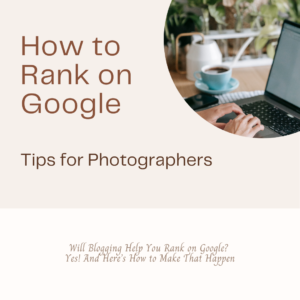Photographers, Here’s How to Write a Successful Blog Post:
If you have aspiring writers among your friends or family members, you’ve probably heard about their ambitious plans for NaNoWriMo (National Novel Writing Month.) Yes, November has become famous (or infamous) among writers as the time to chain themselves to their desks and subsist on food usually reserved for police stakeouts, which I’m not saying isn’t inspiring.
But we’re going to tone it down a little and focus on something a little more bite-sized. No need to write the next Great American Novel (although you’re free to grab coffee and a donut if you feel like it. It’s November after all, and I do love me some comfort food this time of year!) Instead, let’s zero in on how to write your next blog post, with these 10 writing tips for your photography blog.
1. Pick a Topic
First, you’ll want to set yourself up for success by choosing a specific topic. This will keep you on track (we’ve all read those rambling posts where the author didn’t seem sure if they were talking about their vacation, a new recipe, or their best friend’s dog, right?) and make your job easier down the road.
When choosing a topic, make sure it’s something related to your niche. And that doesn’t necessarily mean photography, by the way. Blogs tend to be most successful when they provide information and answers to people. So even if you blog about your sessions, you may also want to pick another area that overlaps both with your expertise and the interests of your audience. For example, if you’re a newborn photographer, maybe you’ll focus on providing tips for new moms. Or if you’re a pet photographer, you could provide pointers on training tips, pet health, or pet care products.
Once you have a general topic, take a closer look at it to see if it’s specific enough to cover thoroughly in a single article. For example, when writing this post, I took it from “blogging tips” and narrowed the focus to a specific type of tip (writing) and a specific type of blog (photography—since photographers make up the bulk of my clientele.)
2. Do Your Research
Got your topic? Great! If it fits into your niche, then chances are you already know a lot about it, but it never hurts to do a little research.
If you think a lot of other people are blogging about the same topic, you might check out what the competition is saying so you can come at things from a different angle. Or dive into the details so you can create a truly comprehensive guide that people will come back to again and again. Maybe all you need is a little fact-checking.
Whatever the case, take some time to get all your materials together—and remember, if you draw on the work of others, only use reliable sources and give credit where it’s due!
During your research phase, you’ll also want to choose your primary keyword or keyphrase, as well as some synonyms you can use. You can dive into more details on selecting a high-performing keyword here, but basically you want a word or phrase that people are likely to search for, but that doesn’t have a ton of competition. (I like to brainstorm a whole bunch of topics and corresponding keywords at the same time—that way I can come up with several months’ worth of content in a single day.)
3. Create an Outline
An outline makes it easy to stay on track, since you know exactly what points you want to hit and in what order. It can also help you to spot places where you need a little more information.
If you’re someone who has a super organized brain and can keep everything straight in your head, you may not need to worry about this step, but most people (raising my hand here) benefit from a road guide when they’re writing.
Your outline may be super detailed, featuring what photos to use and resources to quote at each step, or it may be just a list of bullet points. Whatever works to keep you focused and gives enough structure for you to write that blog post from start to finish!
4. Choose the Right Word Count
Higher word counts tend to perform better for SEO (with around 2000+ word posts getting the most engagement currently, according to most sources.) But the word count does vary from one industry to the next, and it will also vary depending on what topic you’re covering, so there’s no hard and fast rule. (You also have to keep in mind how often you want to post, and how much time you can dedicate to blogging. There’s no faster way to abandon blogging than by setting unrealistic expectations like, “I’m going to post a 2500-word article three times a week!”)
Instead of stressing out too much about word count, just keep that 2000+ word rule-of-thumb in mind and aim to get as close to that as is realistic, given your topic, your writing style, and your posting schedule. As you write more articles, you’ll get a better feel for word count, and will be able to tell at a glance if the topic you’ve chosen merits 2000 words, or if you’ve narrowed down a little too much.
If you’re new to blogging, then a good way to ease yourself into figuring out appropriate word count is just to look over your article when it’s finished and ask yourself, “Have I covered this topic adequately? Are people going to find solid answers to their questions here?”
If the answer is yes, that’s the most important thing. If you’re way over or under your chosen word count, then you can follow up with, “Is this article written in my style and voice? Is there useful information I could add? Is there anything here that doesn’t add value for my readers?” If there’s more great info you could put in to beef up your word count, great. But don’t put a bunch of fluff and extra words in there just to hit a number. If you’ve given people good info (or entertainment, or whatever you’re going for) in your blog post, then you’ve done your job.
5. Craft a Compelling Title
A good title gives your reader some idea of what to expect from your article, even if it also piques their curiosity.
When you create your title, be specific about what readers are going to get out of your blog post. This might be straightforward, like, 10 Writing Tips for Your Photography Blog. Or it might address a pain point or make a promise. For example, Hate Writing? How to Write Painless Photography Blog Posts. Basically, you want your title to let readers know what reading this blog post is going to do for them. If possible, you’ll also want to use your keyword or keyphrase in the title, which should be pretty easy if your title accurately reflects the content of your post.
Beyond this, you can also format your title to be more clickable by using popular headline strategies. A few examples from HostGator:
Number titles (Everyone loves a listicle)
How to titles (“How to” or “Step-by-Step Guide”)
Big promise titles (“Top” or “Ultimate Guide” or just a really big number, like “100 Ways”)
Scarcity titles (“Little Known” or “Secrets”)
I also like to pay attention to other people’s titles and headlines to see what grabs my interest. If I open an article, I take a look at the title and try to figure out what made it sound intriguing. And, when I leave the page, I take a second to evaluate whether I felt like the article was worth my time and why (or why not.)
Just paying attention like this helps me spot patterns I like as well as traps I want to avoid falling into (or making my readers fall into) in my own writing. Doing this helps you make sure that your titles are not only catchy, but that they accurately reflect what your article delivers. You don’t want readers to click on your “Little Known Tips for Writing a Successful Blog Post” and come away disappointed because all you did was rehash material they’ve already heard.
6. Incorporate Your Keywords Naturally
Now that you’ve got the groundwork laid, it’s time to start writing! And if you’ve got a killer keyword that you’re really excited about, it’s tempting to make it the star of every paragraph. But don’t get too carried away. If you want to get into the SEO details of keyword density, I’ve covered them for you here, but if the math scares you don’t worry.
Just focus on incorporating your keyword or phrase and its synonyms in a natural, unforced way and you won’t go far wrong.
Basically, you want your reader to come away feeling like, “Wow, that was really helpful and I learned some great things,” rather than, “Well, we all know what she’s trying to rank for, don’t we?”
7. Use Headings
Even avid readers (raising my hand again) can get a little intimidated by a dense stretch of text—especially on a screen.
If you do end up writing the next Great American Novel, send me a copy—I’ll be glad to curl up with it. But if you’ve got more than about 300 words on a screen, you’re going to lose me unless you break up that text a little.
As a photographer, you’ll probably use images to give the eye a break from all that black and white, which is great! But there’s no substitute for headings. Headings keep your post organized, allow the reader to skim to the bits they’re really interested in, and just make for easier reading.
Headings can also benefit your SEO. Search engines recognize that larger text usually means more important, so if your headings contain keywords and synonyms (again, only where it makes sense) it can make your whole post more search engine optimized.
8. Proofread Before Publishing
Phew! You just wrote a blog post. Way to go!
I know you want to slap that thing up on your site ASAP, but I recommend giving it a proofread first. If possible, have someone else (either a professional or just a friend who loves a good typo-hunt) read through your article once you’re done writing.
Proofreading your own work is kind of tough, because you already know what you’re trying to say! But if you’re on your own, set your article aside for a few days so you can come back at it with fresh eyes. Reading it aloud can also help, since it forces you to slow down and can draw attention to awkward phrases or extra long sentences.
Whatever your method, give that post a good polish before you put it out there for the whole world to see.
9. Find Your Voice and Have Fun!
If you’re not someone who hops on the NaNoWriMo train every year (maybe the extent of your writing is texts and grocery lists—no judgment!) putting a blog post together can feel just as overwhelming as plotting a novel. It takes time to find a writing voice that feels natural and sounds authentic, just as it’s taken time to develop your unique style as a photographer.
Try to enjoy the journey and realize that it’s a process—and an adventure! As you blog consistently every week or month, you’ll find a rhythm, hone your writing style, and figure out what type of blog posts work well for you.
10. Include a Call to Action
Oh, and one more thing. What do you want your readers to do once they’ve read your blog post? Book a session? Comment? Leave a review? Anything you want your reader to do is a call to action.
It’s nice to include one of these in your article (preferably with a handy dandy link so people can easily take action straight from your site) so that if readers are interested, they know how to proceed. I like to put the call to action near either the beginning or end of an article, so it’s easy to locate. Oh, look, here’s mine:
If writing blog posts still feels about as doable as writing a New York Times bestseller every month, I’ve got you! Check out my blogging packages for photographers or shoot me an email at redfoxblogging@gmail.com and let’s put together a custom blogging service designed just for you. With RedFox Blogging, you can free up your time and zoom in on the parts of your business that you’re truly passionate about, all while enjoying the benefits of consistent, hassle-free blogging.
Happy writing, my friends!



